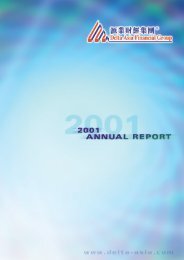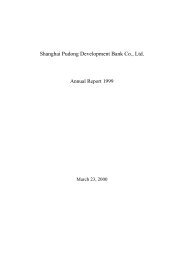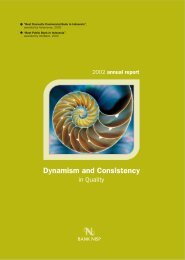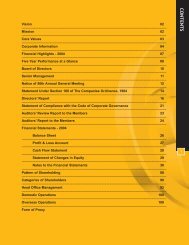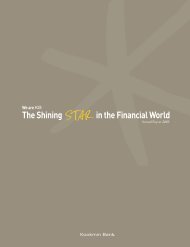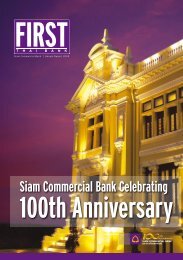Banco de Oro Universal Bank provides a - Asianbanks.net
Banco de Oro Universal Bank provides a - Asianbanks.net
Banco de Oro Universal Bank provides a - Asianbanks.net
- No tags were found...
You also want an ePaper? Increase the reach of your titles
YUMPU automatically turns print PDFs into web optimized ePapers that Google loves.
52 BANCO DE ORO3.28.4 Credit RiskCredit risk is the risk that the counterpart in a transaction may <strong>de</strong>fault and arises from lending, tra<strong>de</strong> finance, treasury, <strong>de</strong>rivatives and otheractivities un<strong>de</strong>rtaken by the Group. The Group manages its credit risk and loan portfolio through the CRMG, which un<strong>de</strong>rtakes severalfunctions with respect to credit risk management.The CRMG un<strong>de</strong>rtakes credit analysis and review to ensure consistency in the Group’s risk assessment process. The CRMG performs risk ratingsfor corporate accounts and risk scoring for consumer accounts. It also ensures that the Group’s credit policies and procedures are a<strong>de</strong>quate tomeet the <strong>de</strong>mands of the business. The CRMG is also responsible for <strong>de</strong>veloping procedures to streamline and expedite the processing of creditapplications.The CRMG also un<strong>de</strong>rtakes portfolio management by reviewing the Group’s loan portfolio, including the portfolio risks associated withparticular industry sectors, regions, loan size and maturity, and <strong>de</strong>velopment of a strategy for the Group to achieve its <strong>de</strong>sired portfolio mixand risk profile.The Group structures the levels of credit risk it un<strong>de</strong>rtakes by placing limits on the amount of risk accepted in relation to one borrower, orgroups of borrowers, and to geographical and industry segments. Such risks are monitored on a revolving basis and subject to an annual ormore frequent review. Limits on the level of credit risk by product, industry sector and by country are approved quarterly by the RMC.Exposure to credit risk is managed through regular analysis of the ability of borrowers and potential borrowers to meet interest and capitalrepayment obligations and by changing these lending limits when appropriate. Exposure to credit risk is also managed in part by obtainingcollateral and corporate and personal guarantees.The CRM reviews the Group’s loan portfolio in line with the Group’s policy of not having significant unwarranted concentrations of exposureto individual counterparties, in accordance with the BSP’s prohibitions on maintaining a financial exposure to any single person or group ofconnected persons in excess of 25% of its Net Worth.3.28.5 Cash Flow Interest Rate RiskThe <strong>Bank</strong> prepares gap analysis to measure the sensitivity of its resources, liabilities and off-statement of condition positions to interest ratefluctuations. The focus of analysis is the impact of changes in interest rates on accrual or reported earnings. This analysis would givemanagement a glimpse of maturity and re-pricing profile of its interest sensitive resources and liabilities. An interest rate gap report isprepared by classifying all assets and liabilities into various time buckets according to contracted maturities or anticipated repricing dates, andother applicable behavioral assumptions. The difference in the amount of resources and liabilities maturing or being repriced in any timeperiod category would then give the Group an indication of the extent to which it is exposed to the risk of potential changes in <strong>net</strong> interestincome.4. BUSINESS SEGMENTSIn the consolidated financial statements, the Group is organized into the following business segments:1) Commercial banking – handles the entire lending, tra<strong>de</strong> financing and cash management services for corporate and retail customers;2) Investment banking – provi<strong>de</strong>s services to corporate clients outsi<strong>de</strong> the traditional loan and <strong>de</strong>posit products. These services inclu<strong>de</strong>loan syndications, un<strong>de</strong>rwriting and placing of <strong>de</strong>bt and equity securities, and financial advisory services.3) Private banking – provi<strong>de</strong>s traditional and non-traditional investment and structured products to high <strong>net</strong> worth individuals andinstitutional accounts.4) Others – inclu<strong>de</strong>s asset management, credit card operations, insurance, securities brokerage and realty management, none of whichconstitutes a separately reportable segment.Transactions between the business segments are on normal commercial terms and conditions.Funds are ordinarily allocated between segments, resulting in funding cost transfers disclosed in operating income. Interest charged forthese funds is based on the Group’s cost of capital. There are no other material items of income or expense between the businesssegments.Segment assets and liabilities comprise operating assets and liabilities including items such as taxation and borrowings.Internal charges and transfer pricing adjustments have been reflected in the performance of each business. Revenue sharing agreementsare used to allocate external customer revenues to a business segment on a reasonable basis.



